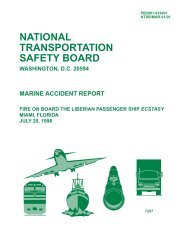Soot Deposits and Fires in Exhaust Gas Boiler - Martin's Marine ...
Soot Deposits and Fires in Exhaust Gas Boiler - Martin's Marine ...
Soot Deposits and Fires in Exhaust Gas Boiler - Martin's Marine ...
- No tags were found...
You also want an ePaper? Increase the reach of your titles
YUMPU automatically turns print PDFs into web optimized ePapers that Google loves.
as predicted, s<strong>in</strong>gle deliveries haveshown exceed<strong>in</strong>gs of the normal data,as a result of a more efficient ref<strong>in</strong>eryprocess. The residual fuel oils availableon the market today conta<strong>in</strong> considerablyhigher quantities of asphalt, carbon<strong>and</strong> sulphur that contam<strong>in</strong>ate the exhaustgas <strong>and</strong> thereby <strong>in</strong>crease the riskof soot deposits on the exhaust gasboiler tubes.In recent years, <strong>and</strong> possibly as a consequenceof both the deteriorated fuel<strong>and</strong> the above highly efficient <strong>and</strong> perhaps“overstretched” design, it also seemsthat the tendency to foul<strong>in</strong>g, i.e. sootdeposits on the exhaust gas boiler tubes,has <strong>in</strong>creased <strong>and</strong>, <strong>in</strong> some cases, hasresulted <strong>in</strong> soot fires. In extreme cases,the soot fire has developed <strong>in</strong>to a hightemperature iron fire <strong>in</strong> which the boileritself burns. The above-mentioned tendencyis confirmed by DnV’s statistics,which reveal a sudden rise <strong>in</strong> soot fire<strong>in</strong>cidents s<strong>in</strong>ce 1985, see Fig. 1 <strong>and</strong>Ref. [1], a rise, which may also havebeen caused by slow steam<strong>in</strong>g of shipsdue to the low freight rates <strong>in</strong> recentyears.S<strong>in</strong>ce 1998, we have aga<strong>in</strong> seen a fall<strong>in</strong> the number of <strong>in</strong>cidents, probablycaused by the effect of the new recommendedexhaust gas boiler design criteria<strong>in</strong>troduced about 10 years ago, <strong>and</strong>described <strong>in</strong> this paper.It is evident that the high fuel efficiencytarget must be met without jeopardis<strong>in</strong>gthe reliability of the ship. It is thereforeimportant to know the ma<strong>in</strong> reasons forthe occurrence of soot deposits <strong>and</strong>fires so we can take the proper countermeasuresaga<strong>in</strong>st them with a correctexhaust gas boiler/system design, etc.Warn<strong>in</strong>g triangle –risk of soot fireIgnition(of the soot)Fig. 2: Warn<strong>in</strong>g triangle - risk of soot fireWhen soot fires occur, the diesel eng<strong>in</strong>ewill normally be blamed s<strong>in</strong>ce the sootparticles <strong>in</strong> fact orig<strong>in</strong>ate from the eng<strong>in</strong>e’sfuel combustion. As, <strong>in</strong> pr<strong>in</strong>ciple, particles<strong>in</strong> the exhaust gases are unavoidablefrom a modern diesel eng<strong>in</strong>e runn<strong>in</strong>g onheavy fuel Ref. [1], the causes of soot deposits/firesmay be approached by ask<strong>in</strong>ga different question: What makes thesoot particles deposit <strong>and</strong>/or whatcauses the ignition of the soot deposits?This question may be illustrated by the“warn<strong>in</strong>g triangle” <strong>in</strong> Fig. 2 show<strong>in</strong>g thethree factors which are all needed for asoot fire: soot deposits, oxygen <strong>and</strong> ignition.As the exhaust gas smoke from adiesel eng<strong>in</strong>e, due to its high air excessratio, conta<strong>in</strong>s about 14% oxygen, thesoot deposits <strong>and</strong> ignition items are ofparticular <strong>in</strong>terest, as the oxygen cannotbe removed.Oxygen O 2(<strong>in</strong> exhaust gas smoke)<strong>Soot</strong> deposits(on boiler tubes)Scope of this paperThis paper is divided <strong>in</strong>to two chapterswhich, <strong>in</strong> pr<strong>in</strong>ciple, may be consideredas two separate papers.The <strong>in</strong>tention with Chapter I is to give aquick <strong>in</strong>troduction to the most commonly-usedexhaust gas boiler types,steam systems <strong>and</strong> relevant parameters.Read<strong>in</strong>g this chapter will form agood <strong>in</strong>troduction before proceed<strong>in</strong>g tothe issues of pr<strong>in</strong>ciple discussed <strong>in</strong>Chapter II.Chapter II deals with the essential conditionscaus<strong>in</strong>g soot deposits <strong>and</strong> fires<strong>in</strong> exhaust gas boilers. The reasons forsoot deposits <strong>and</strong> their ignition are identifiedon the basis of statistical materialetc. In this context, recommendationsare given which are relevant to the design<strong>and</strong> operation of exhaust gas systems<strong>and</strong> boilers.4This document, <strong>and</strong> more, is available for download at Mart<strong>in</strong>'s Mar<strong>in</strong>e Eng<strong>in</strong>eer<strong>in</strong>g Page - www.dieselduck.net
















